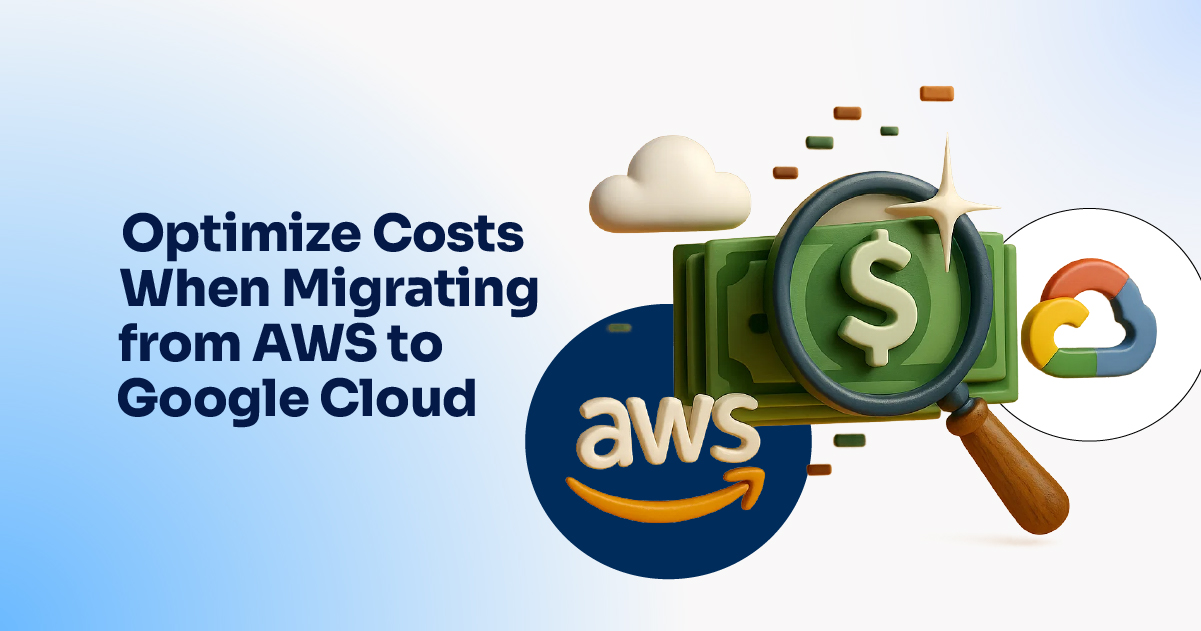
Migrating from AWS to Google Cloud can be a strategic move for businesses seeking better pricing models, innovative tools, and seamless integration with Google’s ecosystem. However, without proper planning and cost optimization strategies, cloud migration can lead to unexpected expenses and operational challenges. In this blog, we’ll explore practical tips and best practices for optimizing costs during and after your migration from AWS to Google Cloud.
Why Migrate from AWS to Google Cloud?
While AWS remains a dominant cloud provider, many businesses are making the switch to Google Cloud Platform (GCP) for several reasons:
- Flexible and transparent pricing models
- Sustained-use and committed-use discounts
- Advanced data analytics and AI/ML tools
- Tighter integration with Google Workspace
- Open-source friendliness
However, these benefits only become cost-effective when paired with strategic planning.
Key Cost Optimization Strategies for Migrating to Google Cloud
1. Conduct a Detailed Assessment of Your AWS Workloads
Before initiating the migration, audit your current AWS infrastructure. Identify:
- Underutilized or idle resources
- Over-provisioned compute instances
- Legacy workloads that can be modernized
- Opportunities to consolidate or eliminate redundant services
This assessment will help you understand your resource requirements and eliminate waste before you move to GCP.
2. Right-Size Your Resources for Google Cloud
Google Cloud offers a wide variety of machine types, storage options, and services. Use tools like GCP’s Right Sizing Recommendations to match workloads with the most cost-effective compute resources.
For example, if you’re running general-purpose applications on AWS EC2 t3.large instances, GCP’s e2-standard-2 might provide similar performance at a lower cost. Over-provisioning is a common pitfall that can significantly inflate your cloud bill.
3. Take Advantage of Sustained and Committed Use Discounts
One of GCP’s standout pricing features is Sustained Use Discounts (SUDs), which are automatically applied when you run virtual machines for a significant portion of the billing month. Additionally, Committed Use Contracts (CUDs) offer up to 70% savings compared to on-demand pricing when you commit to using specific resources over one or three years.
Plan your workloads in advance and leverage these discounts for long-running applications, databases, and production systems.
4. Migrate in Phases to Avoid Downtime and Overlaps
Avoid a big-bang approach. Instead, adopt a phased migration strategy to avoid duplicating resources across AWS and GCP for extended periods. Start with low-risk applications, validate performance and costs, and gradually migrate core workloads.
Using tools such as Google Cloud Migrate for Compute Engine or Velostrata, you can reduce data transfer time and associated costs during the transition.
5. Optimize Storage Costs
Google Cloud provides multiple storage classes—Standard, Nearline, Coldline, and Archive. Choose the appropriate class based on how frequently you access the data.
For example:
- Use Nearline for backups accessed once a month.
- Use Coldline or Archive for long-term data you rarely access.
Proper tiering of storage based on access frequency can lead to substantial savings.
6. Monitor and Set Budgets Post-Migration
After your workloads are live on GCP, it’s crucial to actively monitor usage and costs. Google Cloud’s Billing and Cost Management tools allow you to:
- Set budgets and alerts
- View detailed reports on cost trends
- Identify anomalies in spending
This ongoing oversight ensures you remain within your budget and can proactively adjust resources as needed.
7. Use Preemptible VMs for Batch Workloads
If you have non-critical, stateless, or batch-processing jobs, consider using Preemptible VMs. These instances are up to 80% cheaper than standard VMs and are ideal for workloads that can tolerate interruptions.
Although they come with the trade-off of limited runtime (up to 24 hours) and possible preemption, the cost savings can be significant.
8. Leverage Cloud Migration Services
If you lack the internal expertise or resources to manage the migration efficiently, consider engaging professional Cloud Migration Services. These services provide end-to-end support—from planning and execution to optimization—ensuring a seamless and cost-effective transition to GCP.
Cloud migration specialists can also help you choose the right architecture, reduce licensing fees, and integrate with your existing tools for smoother adoption.
9. Take Advantage of Google’s Free Tier and Credits
GCP offers a generous Free Tier and often provides promotional credits to new customers. These can offset your initial costs, especially during testing and validation phases. Be sure to utilize these offers to reduce early-stage expenditures.
10. Automate and Use Infrastructure as Code
Managing your infrastructure using tools like Terraform or Deployment Manager ensures consistency and prevents configuration drift, which can lead to cost leaks. Automation also allows you to shut down or scale down resources during non-business hours, further optimizing costs.
Conclusion
Migrating from AWS to Google Cloud can unlock powerful tools and cost-saving opportunities, but only when done strategically. By conducting a thorough assessment, right-sizing your resources, leveraging GCP’s pricing models, and working with expert Cloud Migration Services, you can ensure a smooth transition without breaking your budget.
The key to cloud cost optimization lies in continuous monitoring, smart planning, and making full use of the features Google Cloud offers. With the right approach, your business can benefit from increased performance, better integration, and long-term savings.
